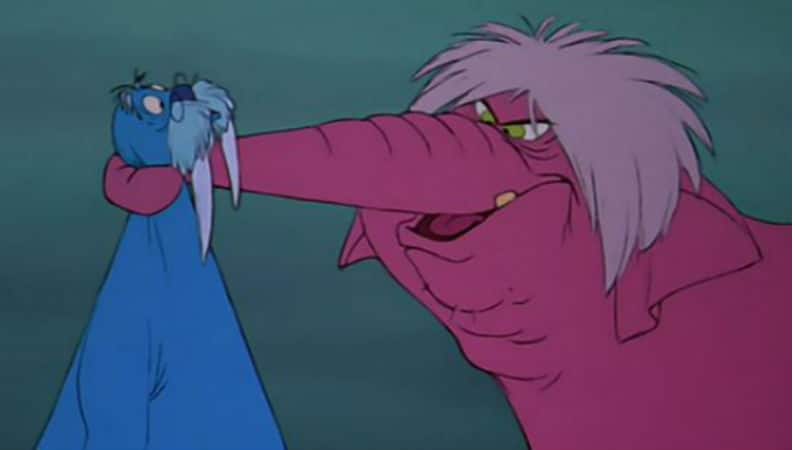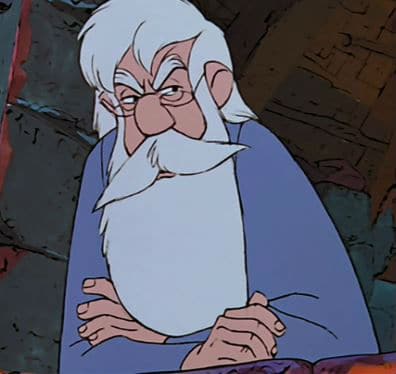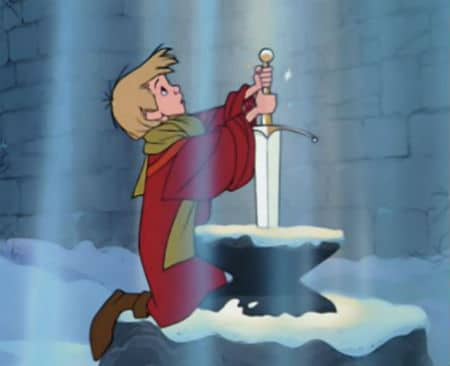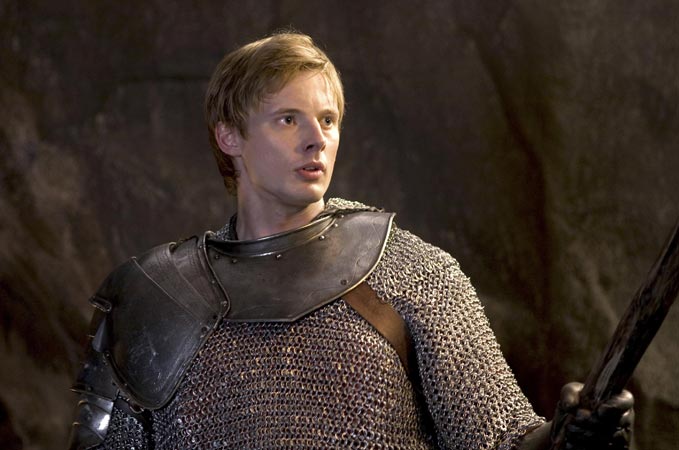
Welcome to Revisiting Disney! Today, we’re looking at that movie which starred one of my favorite heroes, The Sword in the Stone! Like always, I have labeled each category so if you want to skip to the parts that interest you most, feel free. And, of course, if you have any thoughts, burning or otherwise, please share in the comments!
BACKGROUND – THE SWORD IN THE STONE
The Sword in the Stone is the next Disney movie in the official canon, and, honestly, it’s exactly the kind of Disney movie that I would have thought Young Bailey would have been obsessed with. I’ve always been a major fan of the King Arthur legends; like, if I had to pick one thing to be a nerd about for the rest of my life, the King Arthur legend might be that thing. For some reason, however, The Sword in the Stone was never my favorite Disney film (I was more of a Robin Hood girl, myself, but we’ll get to that).
I did a little test when I was getting ready to write this, and I realized that I own more books and films about King Arthur than any other single subject. It’s a stack at least a foot high, and I’m not ashamed of it, just surprised when I think about my Sword in the Stone feelings as a kid.
This source material section is going to be really fun to write, and if you have strong King Arthur-related feelings, let me know in the comments; I love to talk about this legend! There’s just so much to unpack and discuss.
Back to the film itself, The Sword in the Stone was released in December of 1963, on Christmas Day. It was a unique film in that it was directed by just one man, Wolfgang Reitherman while the other Disney films had been directed in sequences by several different people.
Unlike the other Disney films of the 1960’s (101 Dalmatians and The Jungle Book), which had live-action remakes, a Platinum DVD release, a sequel and a television show (if you count Tailspin, which I do), The Sword in the Stone got nothing other than an occasional re-release, marking it as not one of the Studio’s favorites of their projects.
Wolfgang Reitherman was one of the Nine Old Men and had directed sequences in several films (parts of 101 Dalmatians and the climactic battle scene in Sleeping Beauty). Before working as a director, he worked as an animator for Disney, typically animating scenes with action, like the fight between Tramp and Rat in Lady and the Tramp, and sequences involving dancing.
Like Marc Davis and Milt Kahl, Reitherman had to train as a draftsman, working for Douglas Aircraft. He had joined the Disney Studio in 1934 though he also served in the Army Air Corp (which would become the Air Force) during World War II.
Reitherman saw action in Africa, India, China and the South Pacific, winning the Distinguished Flying Cross. He and his wife, Janie, had three children (Bruce, Robert, and Richard), who he often used in his films. Richard and Robert, together with Rickie Sorensen, provided the voice of Wart in The Sword in the Stone, explaining why the voice changes at times (I always thought it was just because he was voiced by a 12-year-old boy). Wolfgang Reitherman was born in June of 1909 in Bavaria, Germany and passed away in May 1985 in Burbank, California.
MUSIC
The Sword in the Stone doesn’t feel like it, but it is technically a musical. The fun songs are pretty catchy, though short. What makes this film stand out to me, however, is the fact that this was the Disney animated film to include music written by the Sherman Brothers, Richard M. and Robert B.
The duo would have a long-standing relationship with the Disney Studio, writing for Disney directly in both animated and live-action films until his death in 1966. Before Robert’s death, the brothers had earned nine Academy Award nominations, two Grammys, four Grammy nominations, and 23 gold and platinum albums.
After leaving the Disney Company, the Sherman Brothers worked freelance on a variety of projects, including musicals, films, television shows, and theme parks (they wrote the hit It’s a Small World). The duo also wrote the songs for the 1968 film Chitty Chitty Bang Bang, 2000’s The Tigger Movie, the additional songs for the 2002 stage version of Chitty Chitty Bang Bang, 1972’s Snoopy Come Home, 1964’s Mary Poppins, and many others. They were given a star on the Hollywood Walk of Fame in 1976.
In 2008, the Sherman Brothers were awarded the American National Medal of the Arts by President George W. Bush. They were given a window on Main Street Disneyland in 2010 and honorary doctorates from Bard College in 2011. They were portrayed in Saving Mr. Banks by BJ Novak (Robert) and Jason Schwartzman (Richard).
Robert Sherman was born in Brooklyn in 1925 and would pass away in London in 2012. He served in the military during WWII, earning the Purple Heart. He also was in the first group of Allied troops to enter the Dachau Concentration Camp in 1945; he had accidentally led the group (though how, I’m not sure). Soon after, he was shot in the knee and would be using a cane for the rest of his life.
Within a few years of Robert’s graduation from Bard College in 1949 (he studied English Literature, painting, and wrote his first two novels while in school), he and his brother began writing songs. This was a challenge from their father Al, himself a songwriter. Despite his songwriting career, Robert had dreamed of writing the “Great American Novel,” and had written several novels before his death.
Richard Sherman was born in June of 1928 in New York, New York and is still living today. Like his brother, Richard attended Bard College in New York, though he studied music, writing some sonatas and art songs and he was determined to write the “Great American Symphony.” He currently lives in California with his wife, Elizabeth.
The score was arranged by my new favorite composer, George Bruns (who had previously arranged Sleeping Beauty and 101 Dalmatians). The film’s 1964 Oscar Nomination was in the category of “Best Music, Scoring of Music, Adaptation or Treatment.”
ANIMATION
The animation in The Sword in the Stone is very similar to the animation in 101 Dalmatians; stylistically modern with minimalist backgrounds. It’s a stark contrast to the detailed animation of the earlier films, but it still looks great. It’s just different.
Of the Nine Old Men, six are left. John Lounsbery, Milt Kahl, Frank Thomas and Ollie Johnston served as Directing Animators, Eric Larson was a character animator and Wolfgang Reitherman, as mentioned earlier, was the director. Milt Kahl also worked with Bill Peet on character design. Ken Anderson was in charge of Art Direction like he was in 101 Dalmatians.
According to the IMDB page, the battle between Merlin and Mim is called one of the best bits of character animation to that point in time. The idea behind this is that as the characters change their forms, you can still tell who they are. Merlin is always blue with facial hair and glasses while Mim is pink and purple with her signature messy hair.

This film continues the use of the Xerox method and also uses recycled animation in a way that earlier films had not. Reitherman liked using callbacks to earlier films in films he directed (Bambi’s mom makes an appearance), and when characters repeat motions, there are times when the same animation is used. This isn’t new, but it is a step in a new direction for Disney.
Animation historian Adrian Bailey says that “The Sword in the Stone failed on all levels except the animation” (Bailey 1982:223). Another animation historian, Christopher Finch, also doesn’t speak highly of the film, saying that “it was not one of the Studio’s better efforts…the film totally misses the tone of T.H. White’s story” (Finch 1975: 123). Finch does admit that the animation is “as accomplished as ever,” but is especially unhappy with the portrayal of Merlin (Finch 1975:123).
THE PLOT OF THE SWORD IN THE STONE
Bill Peet, who wrote the previous Disney film, 101 Dalmatians, also wrote The Sword in the Stone, basing it off of the first book of TH White’s The Once and Future King. I’ll come back to that later, but the basic plot focuses on King Arthur’s childhood and his learning from Merlin, ending in his pulling the sword from the stone, thus revealing that he is the rightful King of England.
Our story begins first with a picture of the titular sword in the stone and the credits, a trend that I personally love now that I’m older. It annoyed me as a kid, but today I think of it as a trend that encourages and kind of forces audiences to watch the credits and see who was involved in the making of the film.
After this, we see a book titled The Sword in the Stone and hear a song about the prestory. It’s the story of a nation without a leader, full of fighting and conflict to determine who would rule next. With the kingdom on the brink of war, a miracle occurred in London; a sword appeared in a stone, with an inscription on it, “Whoso pulleth out this sword of this stone and anvil is rightwise king born of England.”
Of course, everyone has tried to pull the sword from the stone, but no one could do it. So, as the story goes, the people forgot about the sword and the kingdom descended into darkness and chaos, with the strong taking advantage of the general lawlessness.
At this point, we meet Merlin, a wise but slightly crazy seeming wizard, and his cynical owl Archimedes, who are waiting for a special guest. Merlin is going to prepare him for his destiny, and although Archimedes is skeptical, Merlin pulls up a chair and is ready for his guest to drop in.
That guest is young Arthur, called Wart. He had gone hunting with his foster brother Kai and accidentally caused Kai to lose his arrow in the woods. Determined to prove to Kai that he is worthy to be his squire, Wart goes after the arrow (almost getting eating by a hungry wolf multiple times).
He does fall in through the roof and meets Merlin and Archimedes, who tell him he needs an education because knowledge is power. Merlin packs up and goes with Arthur back to his home, the castle of Sir Ector. Ector has been worried about Wart because he hasn’t returned yet; young Arthur was left in Ector’s care. Although Ector is reluctant, he agrees to let Merlin teach the Wart, as long as it doesn’t interfere with his duties around the castle.

Soon after, Sir Pelinore, a friend of Sir Ector, arrives with news that there will be a grand tournament in London soon, and the winner will be King of England. Wart is told that if he does his duties, he can go as Kai’s squire. Merlin is not excited for him, as he is trying to encourage Arthur to grow his brains rather than his brawn, and the two transform into fish to learn hands-on problem solving and logic.
Strangely enough, there is a large barracuda in the moat that gives chase to the two small fish. With the help of Archimedes and his new-found logic, Arthur is able to escape. Soon after, he is doing dishes when Merlin wants to have another lesson. He magically enchants the dishes to wash, and turns the two of them into squirrels.
The lessons here are great, including, “Look before you leap!” and a discussion on gravity. A girl squirrel falls in love with the Arthur-squirrel and saves him from the wolf, prompting Merlin to tell Arthur that love is the strongest force on Earth. When Arthur asks if it’s even stronger than gravity, Merlin says yes, it is. The poor hungry wolf is never seen again.
When they come back, Ector and Kai are mad because Arthur was late getting back, thought he was a squirrel, and they got trapped by the magic happening in the kitchen. As a result, Arthur is no longer Kai’s squire, and he is crushed. Arthur’s education hits a snag because of his sadness and with Archimedes offering sarcastic commentary, Merlin is fed up, so Archimedes takes over as the teacher.
This new lesson involves learning the ABCs and is soon followed by Archimedes teaching Arthur how to fly. He does well, but a hawk appears, driving Arthur back into the forest where he encounters the witch, Mad Madam Mim. When she learns he is important to Merlin, she decides to kill him on principle (since she is evil and Merlin is good).
Merlin and Archimedes show up to save the day and Merlin challenges Mim to a Wizard Duel. The fight is to the death, and the rules are simple. The two of them transform into animals and try to kill the other. The catch is that they can only transform into real animals. Of course, Mim cheats (being evil and all), but Merlin turns into a germ and wins. Infected with a disease, Mim is stuck in bed.
Soon after, Kai’s squire gets sick, so Arthur gets to be his squire after all. Merlin is annoyed and flies away to Bermuda, but Archimedes stays behind to offer advice. Archimedes and Arthur go to the tournament with Ector and Kai and, through a series of accidents, Arthur goes looking for a sword. Of course, he happens to stumble across one in a churchyard, stuck in a stone.

He pulls it out with ease and runs back to the tournament, where no one believes that he pulled it from the stone. Ector puts the sword back in the stone and all the knights at the tournament try to pull it out again. Everyone fails, and when Arthur succeeds, again, he is acknowledged as King.
Arthur feels overwhelmed because he’s only twelve. He and Archimedes try to escape, but the adoring crowds have them surrounded. Merlin comes back and promises to guide the young King, asking him if he would prefer a square table instead of a round one (that line cracks me up every time). And with that, the movie ends.
SOURCE MATERIAL
The King Arthur legends are immensely popular but are still shrouded in mystery. Was King Arthur based on a real person and real events? There are stories about that. Was his half-sister Morgan Le Fay evil? There are stories about that. Was she good? Those stories are out there. Was Merlin related to Arthur? There are stories about that too.
Prequels to Arthur’s reign, futuristic retellings, reincarnation plots, “historical” stories, Merlin-based stories, women-based stories, Gawain-based stories, Old Arthur, Young Arthur, Middle-Aged Arthur and Excalibur (that movie tries to cover it all), all of those stories have been written and rewritten and, frankly, there is still more material to write.
RELATED: Mandi’s 6 Favorite Arthurian Knights
If you just search the character of King Arthur on IMDB, there are 147 different appearances by Arthur in television and film, ranging from 1909 to the 2016 Knights of the Round Table: King Arthur (which I, for one, am very excited about).
Some of these are just small appearances in long-running shows (there was a King Arthur appearance in The Simpsons, an Avalon-themed season of Stargate SG-1, an Animaniacs episode, and a whole slew of other shows), but the story of King Arthur is one that has persisted and grown over the years.
The story of King Arthur starts before the main character is born. There are several versions, but the basic gist is the same across the board. In the next few paragraphs, I’m going to attempt to summarize several centuries of mythology in six sentences, so, here goes. King Uther dies and he wants to make sure his heir rules, either he or Merlin puts his sword in the stone, and it is set up so only the true king can pull it out of said stone.
Arthur has been raised by Sir Ector with a foster brother named Kai, sometimes he’s treated well and sometimes he’s treated badly. After a point, he finds himself pulling the sword from the stone and being crowned king. Eventually, he finds a queen and a group of knights to sit around his round table.
Throughout the legends, many adventures are had and quests undertaken, by both Arthur and his knights. In the end, Arthur dies or almost dies (always by treachery, sometimes in battle) and is taken to the Island of Avalon, where he will return from some day.

The legends change throughout the years, however. In some stories, Sir Gawain is a great knight, in others he’s an idiot (usually, Gawain looks less good when Lancelot enters into the stories). Morgan Le Fay, sometimes called Morgana, isn’t always evil, sometimes she’s good. Morgause is usually evil, but sometimes she isn’t, and she is often left out of the story entirely. Some focus more on Merlin, others are prequels and focus more on Uther.
Gawain isn’t the only major character to change in retellings. In the King Arthur myths, there are possibly three different Guinevere characters in all the legends, and only one of them is unfaithful. In fact, it isn’t until later in the legends that the Lancelot/Guinevere/Arthur triangle is introduced. The main villain, Mordred, is usually Arthur’s son, but sometimes he’s not. It all depends on who is telling the story and who their favorite characters after Arthur are.
RELATED: 7 Bromances to Melt Your Heart
There has also been a trend recently to have Arthur set in a historical setting. Sometimes, the story takes great trouble to highlight how the story could be true; there’s usually some sort of part-Roman, part-Saxon, part-original inhabitant, but all British thing going on. Sometimes people hate him because they want his power, sometimes it’s a grudge against what his father has done, and sometimes he accidentally earned the hatred when he was young and stupid.
The Once and Future King was published in 1939 and added itself to a long list of King Arthur adaptations. People have been rewriting these legends for centuries. Alfred, Lord Tennyson, Thomas Mallory and other earlier authors whose names we have forgotten all took a turn. The stories change in the details, as stories written and adapted over centuries will do.
In all the stories, however, King Arthur is a just and kind king, a man who is trying to be a good man and a good king; one who is almost universally liked by his subjects and in most stories, he’s really only opposed by evil. Even in stories where he is opposed by characters who aren’t evil, they still have some respect for him as a ruler, a person or both.
I think King Arthur is so popular and has endured for so long because it’s a story of a man who was destined for greatness and tried his hardest to live up to that calling. The fact that the legends may be based on real people adds to the appeal because it proves that everyone has greatness in them (we may not all be an Arthur, but that doesn’t matter. We can be a Gareth, a Gawain or a Galahad).
And in the end, good always wins. Even when it looks like Arthur is dead and Camelot has fallen, there’s hope. We either learn that he’s not really dead or are reminded that the ideas he championed as king lived on.
Finally, the King Arthur Legends are just fun. We’ve been rewriting and adapting them for centuries, sharing them, making movies and TV shows about them. We still haven’t run out of new ways to tell these stories, and people still want to tell them. That is a powerful and enduring legend right there.
The 1960’s
The 1960’s were an era of great change and unrest in the United States. In 1960, a charismatic young Senator from Massachusetts, John F. Kennedy (a Catholic of Irish descent) ran for and won the office of President (being both the youngest president at 43 and the first Catholic president as well). JFK would be assassinated on November 22, 1963, in Texas, an unsolved crime (depending on what you believe) which is still seen today as one of the greatest mysteries of the last hundred years.
JFK promoted what was called “The New Frontier,” an agenda that was trying to eliminate injustice and inequality (it was blocked, but it shows the growing realization in the 60’s that things were wrong with the way American society worked). JFK was sworn in on January 2nd.
According to a History Channel biography, JFK was a very popular president both in America and world-wide. He had a beautiful wife, Jackie Kennedy (who was regarded internationally as a symbol of sophistication, beauty and style), and two beautiful children. The Kennedy’s were often compared to King Arthur’s court at Camelot, and that has been the title of some books about the Kennedy Years in the White House.
With that in mind, the adaptation of a King Arthur story that was developed in the early 60’s can, and has been, seen as a salute to the Kennedy family. This theory is further supported by the fact that the youngest Kennedy, little Jack (or John Jr), supposedly looked like the Disney Studio’s Wart. Whether or not it’s true, it’s a fun story that binds together a much-loved leader in American history with a much-loved symbol of justice.
Other things were brewing in 1960. On February the 1st, four African American men sat at a whites-only counter at a North Carolina Woolworth’s, which set the trend (for lack of a better word) for sit-ins as a way to protest segregation and protest the lack of civil rights faced by many Americans.
In March of the same year, Elvis returned from his time in the army and began his career, giving a voice to the dissatisfied youths of the decade, who were rebelling against the ideas of the 50’s. Television was growing in popularity and the overarching theme of the decade could be called rebellion, rebellion against unfair and unjust policies and trying to create a new way forward for the nation. The 60’s were a decade of extreme change, and we’ll talk about the late 60’s a bit more next week.
LESSONS LEARNED
There are several lessons that can be taken from The Sword in the Stone. First of all, as Merlin tells young Wart, love is the strongest force on earth. It’s even stronger than gravity.
From the film, we also learned that the world is full of dangerous things, even if we can’t see it. When Wart is in the forest, a hungry wolf is chasing him and nearly catches him several times. He doesn’t even realize that there was a wolf after him until he is almost eaten in his squirrel form. Just because he didn’t know he was in danger, however, didn’t mean he wasn’t in danger.
And similarly, when he was a fish, he didn’t know that he was in danger of being eaten by a barracuda, but he was. It was an unfortunate lesson, but he still learned both to always be on his guard and that you can’t always rely on luck.
Another great lesson is that brains are better than brawn. Tiny little Wart-fish is able to outsmart the barracuda in the moat, the girl-squirrel outsmarts the wolf, and Merlin uses his wits to outsmart Madam Mim.
Also, the whole movie, Merlin is determined to teach Arthur that the real power is knowledge and wisdom, so that’s another lesson we can take from this movie.
Finally, I suppose you can take from The Sword in the Stone the idea that if you have a destiny, you can’t escape it. Arthur was destined to become king and through a series of strange and unexpected circumstances he finds himself in a place to pull the sword from the stone, proving himself to be the king. Even though he wanted to escape, he really couldn’t, because it was the job that he was destined for (of course, this talk of fate and destiny reminds me of Tangled, but we’ll get to that eventually).
DOES THE SWORD IN THE STONE HOLD UP?
The Sword in the Stone was not a well-received film and it often gets forgotten, being between 101 Dalmatians and The Jungle Book. Despite the fact that it follows a much-beloved story, in some ways, the story can seem a little scattered, and even for a movie about King Arthur, it’s kind of weird. Although it’s drawing on a wonderfully rich set of legends and is regarded as a bit of a cult classic, it is not one of the Disney Studio’s better films. However, because of the animation and the new look at the King Arthur legends, it’s still well worth a watch. Not every animated film is a hit or beloved by everyone, after all. That’s what makes the world go round.
For next week: The Jungle Book
What do you think about The Sword in the Stone? Sound off below…
If you enjoyed this post and the others in the Revisiting Disney series, and have found yourself wishing that you could find them all in one convenient and bound book with eight extra essays, there is an option for you! Check out A Journey Through Disney: My Look Back Through Disney Canon, now available on Amazon as both a Kindle book ($4.99) and a paperback ($11.99).
OTHER SOURCES:
https://thewaltdisneycompany.com/about-disney/disney-history
http://www.history.com/topics/1960s
http://www.imdb.com
http://studioservices.go.com/disneystudios/history.html
http://www.usnews.com/news/articles/2010/03/09/the-1960s-a-decade-of-promise-and-heartbreak
Bailey, Adrian. Walt Disney’s World of Fantasy. Everest House Publishers. New York, New York. 1982.
Collodi, Carlo. Pinocchio. Tor Publishing. New York, New York. 1996.
Finch, Christopher. The Art of Walt Disney: From Mickey Mouse to the Magic Kingdom. Harry N. Abrams, Inc. New York, New York. 1975.
Sale, Roger. Fairy Tales and After: From Snow White to E.B. White. Harvard University Press. Cambridge, MA, 1978.
Tatar, Maria. The Annotated Classic Fairy Tales. W.W. Norton and Company. New York and London, 2002.
Thomas, Frank. Disney’s Art of Animation From Mickey Mouse to Hercules. Hyperion. New York, New York. 1992.
Wright, Gordon. The Ordeal of Total War: 1939-1945. Harper Torchbooks, Harper & Row. New York, Hagerstown, San Francisco, and London, 1968.
ARE YOU A ROMANCE FAN? FOLLOW THE SILVER PETTICOAT REVIEW:
 Our romance-themed entertainment site is on a mission to help you find the best period dramas, romance movies, TV shows, and books. Other topics include Jane Austen, Classic Hollywood, TV Couples, Fairy Tales, Romantic Living, Romanticism, and more. We’re damsels not in distress fighting for the all-new optimistic Romantic Revolution. Join us and subscribe. For more information, see our About, Old-Fashioned Romance 101, Modern Romanticism 101, and Romantic Living 101.
Our romance-themed entertainment site is on a mission to help you find the best period dramas, romance movies, TV shows, and books. Other topics include Jane Austen, Classic Hollywood, TV Couples, Fairy Tales, Romantic Living, Romanticism, and more. We’re damsels not in distress fighting for the all-new optimistic Romantic Revolution. Join us and subscribe. For more information, see our About, Old-Fashioned Romance 101, Modern Romanticism 101, and Romantic Living 101.


I think Merlin is terrible to Arthur. The poor kid runs in with excitement at the end over being Kay’s squire and Merlin totally rejects him. Arthur is literally in tears, saying “What do you want me to be? I’m nobody…I’m lucky to be Kay’s squire”. He has a point. Merlin has given him no goal beyond ‘something, something, knowledge’. Merlin then literally abandons him. The talking owl was more faithful to Arthur. He actually is supportive to Arthur and he is actually the one that points out the sword in the stone to him.